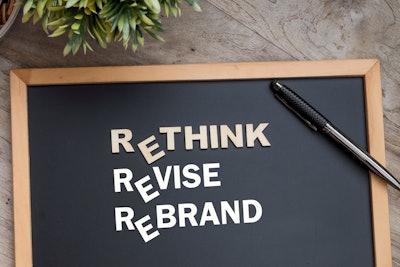
When event tech companies MeetingPlay, Aventri, and eventcore completed their high-profile merger this year, the newly united team knew they needed a name that captured the all-in-one event solution concept they wanted to create for their clients. The result? Stova, an abbreviation of the words “standing ovation."
"We were three individual brands, each with its own history and brand equity, and it was important that we encapsulate the essence of all three brands when choosing a new name for our organization," explains Stova CEO Eric Lochner, adding that the team took the time to interview clients, employees, and industry partners to learn what they valued most about the company. "That feedback was integral in helping us create a brand that represents not just who we are as one organization, but what we represent for our clients."
The new name serves, in part, as a tribute to those clients and the work they do. "Our clients produce multiple events a year. From small to large, the focus is always the same—to create epic events that engage and delight their attendees," Lochner says. "A standing ovation represents that goal, and our role in partnering with our clients to help them create epic events."
BizBash chatted with Lochner and other event and marketing experts about the biggest things to consider when planning an event-company rebrand.
When is it time for a rebrand?
Channing Muller, principal of DCM Communications—who works as a marketing coach for event professionals and other small businesses—suggests asking yourself several key questions: “Do people get confused by what you do? Do you think your branding no longer represents who you are as a company? Are the prospects you attract not the ones you want to be attracting? And have your services/products changed since the inception?”
If you answer yes to one or more of these questions, Muller notes that it might be time for a rebrand. “There are some graphic designers who I hear say, ‘A brand shouldn't be about you; it’s about your target client.’ However, I disagree with them,” she says. “A strong brand represents who you are and resonates with your target client.”
To Muller, a brand is far more than just a logo. “It’s the name of your business, the logo, colors, typography, tone of voice in copy, textures in graphics, and overall image you convey digitally and in person,” she says. “By showcasing that authentically, you will attract the right people for you—particularly as a service business.”
DeNeitra Burnett, the CEO and creative director of Savvy Creative Agency, recently underwent a rebrand from the previous name of Savvy Events. For her, the catalyst was the changes her company underwent during the pandemic. “We added an entirely new custom mailer branch of our business, originally out of necessity. But, between the deep relationships we cultivated with our clients, our marketing savvy, and our distinct, detailed-oriented design style, we sparked a full-fledged evolution of the business,” she says.
Once she recognized that the custom mailer branch of her company was here to stay, “I decided that we needed to rebrand to match the expansion and evolution of who we are and what we do,” she remembers.  In September, DeNeitra Burnett rebranded her company from Savvy Events to Savvy Creative Agency to better reflect the full-scale event and creative services she offers, including customized event mailers (like this one promoting Peacock's Bel-Air series).Photo: Courtesy of Savvy Creative Agency
In September, DeNeitra Burnett rebranded her company from Savvy Events to Savvy Creative Agency to better reflect the full-scale event and creative services she offers, including customized event mailers (like this one promoting Peacock's Bel-Air series).Photo: Courtesy of Savvy Creative Agency
Should I work with a branding expert?
“Just as teams come to us since we’re the expert in live events and custom mailers, we sourced experts to help us out with the rebrand,” notes Burnett, adding that the agency she worked with guided her team through the entire process of rebuilding the company’s foundation from the ground up.
“We aren’t just event planners—we’ve always been strategists, marketers, designers, and experience architects. We wanted our new site and messaging to fully reflect the high caliber of work we produce and the elevated clientele we work with,” she explains. “With that in mind, we dove right in! The process included everything from analyzing the shift in our target audience to adjusting our messaging accordingly to a refresh of our colors for a more luxe feel.”
What if I can’t commit the time and money to a full-scale rebrand right now?
“I tend to recommend you either do it fully and do it right, or wait until you have the time/bandwidth/budget to do it that way,” advises Muller—but she does think that certain elements can be done in stages, as long as they’re grouped together appropriately.
What does that mean? “All digital assets should be done at the same time,” Muller cites as an example. “If you are going to invest in a new logo or colors, update your website, email signatures, etc. at the same time. All elements of your digital footprint should be aligned. After all, that is where most people will either find you, or research you before buying.”
Muller notes that consistency in digital marketing conveys a sense of consistency in overall business practices, too. “If you look like a hot mess online when someone researches your company, they are going to think you are a hot mess offline as well—whether that’s the case or not.”
How do I get the word out?
Once you put the effort into a rebrand, it’s crucial to educate current and future clients to eliminate confusion. To introduce her rebranded company, for example, Burnett worked with a social media manager and business coach. “The plan we designed together included a campaign featuring video and photo teaser content to pique interest,” she remembers. “People knew something big was on the horizon with the fun buildup on social leading up to the launch.”
On launch day, Burnett took a two-fold strategy. For recent clients and partners, her team actually sent out a custom mailer to tangibly showcase the new service. “When you opened the box, a video started playing that shared our new look, our warehouse, and our team,” she says. “We immersed them in the whole vibe of our new brand in that box. Inside, with a bottle of wine and custom glassware, we also had a short marketing piece that explained our vision for this next era of Savvy.”
For others, Burnett sent a personalized email explaining the transition and invited them to “cheers with us” by gifting a Starbucks gift card. “It was our way of saying thanks for their continued support, while also explaining what was on the horizon,” she says. “Saying thank you was a big one for us with the rollout campaign.”
Muller agrees with this approach of starting with your most invested contacts. For larger companies, “Step one is to alert all employees via an internal email that is followed up by each department head calling a team meeting to address any questions,” she suggests. In the email, make sure to explain why you decided to rebrand, how it will affect the company, what remains the same and what will change, etc. “Reiterate your values and driving commitment that got these people invested in you to begin with,” she says. “Change is scary. This is important to keep people excited rather than scared of what’s next.”
From there, Muller advises reaching out to current clients, followed by former/non-active clients, followed by prospects. “After everyone with skin in the game has been alerted, then you release to the press and on social media,” she says, adding: “The message needs to be more than ‘We have a new brand!’ or ‘We have a new website!’ No one cares about that beyond the owner and the marketing team who made it. Make sure you give a reason why anyone else should care to explore the new brand/website.”
 Stova unveiled its rebrand at IMEX America in October. See more: The Top 3 Things Everyone Cared About at IMEX 2022Photo: Vincent Murphy/BizBash
Stova unveiled its rebrand at IMEX America in October. See more: The Top 3 Things Everyone Cared About at IMEX 2022Photo: Vincent Murphy/BizBash
Above all, Stova worked to ensure that clients clearly understood the impetus for the brand changes in order to minimize any impact they may be concerned about, "and ensured them of our continued level of service and commitment," says Lochner, who notes that the team also leveraged social media, email, press releases, and industry partners to help amplify the new message and branding. "Bringing three organizations together is a process. We wanted to ensure our clients, prospects, and partners were communicated to often and effectively."
Should I include words like "formerly known as" in my communications for a while?
If you're going through a full-scale name change, it might not be a bad idea. "We will continue to incorporate MeetingPlay, Aventri, and eventcore in our branding for a period of time to ensure that brand equity is retained," Lochner notes. "Our advice is to make sure you don’t lose sight of why you are rebranding in the first place. Communications should be focused with your clients and prospects in mind. If you aren’t connecting your brand strategy with their pain points, it’s likely harder for your constituents to connect to your new brand."  Many of these concepts apply to event rebrands too, like The Utility Expo, which rebranded from the International Construction Utility Equipment Exposition in 2021. "The previous iteration was a very mature show that needed a shot in the arm in order to grow and reach new audiences," explained John Rozum, senior director of utility exhibitions and events at the Association of Equipment Manufacturers. "We went for a self-marketing name that truly resonated with our audience. ... We [also] introduced new, energetic colors and a new brand identity to align with the energy of the industry." See more: Most Innovative Meetings 2022: The Utility ExpoPhoto: Courtesy of AEM
Many of these concepts apply to event rebrands too, like The Utility Expo, which rebranded from the International Construction Utility Equipment Exposition in 2021. "The previous iteration was a very mature show that needed a shot in the arm in order to grow and reach new audiences," explained John Rozum, senior director of utility exhibitions and events at the Association of Equipment Manufacturers. "We went for a self-marketing name that truly resonated with our audience. ... We [also] introduced new, energetic colors and a new brand identity to align with the energy of the industry." See more: Most Innovative Meetings 2022: The Utility ExpoPhoto: Courtesy of AEM
What other behind-the-scenes logistics or challenges should I be thinking about?
“Y’all, there were so many logistics!” laughs Burnett when remembering her rebrand process. “Maybe the biggest undertaking was filing our new LLC with a DBA for Savvy Events. This way, if some clients still made payments to Savvy Events versus Savvy Creative Agency, we could still deposit those into the right accounts.”
Due to the company name change, Burnett also changed all company email addresses (but made sure to forward emails sent to the old business name). “It was key for our success that there wasn’t a lag in receiving emails, so this was huge,” she says. “Along with changing emails, we had savvy-events.com redirects built out, changed voicemail greetings, designed brand-new email signatures, etc.”
And from a branding perspective, Muller suggests thinking about every single aspect of your operations that might have an old name on it—including proposal and presentation templates, invoices and checks, contracts, employee signatures, official letterhead, and more. Think through your swag items too (“do not give out old logo items at events or allow your employees to wear clothing with old logos to any official work events,” she cautions), along with company cars and equipment.
Lochner, meanwhile, jokes that he could spend a week explaining the tips and challenges that went into Stova's full-scale rebrand. But his number-one piece of advice? "Keep it focused on your clients. Take the time to solicit feedback from your constituents, and bring them along with you for the journey," he sums up. "A rebrand for the sake of a rebrand is meaningless. It's all about listening to your clients and ensuring that you are building products and services that meet their changing needs."



















